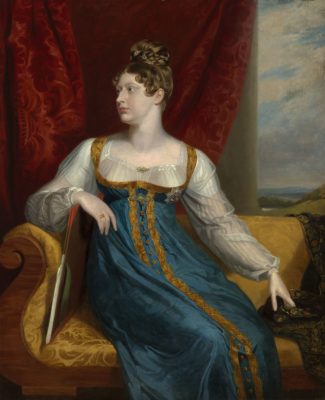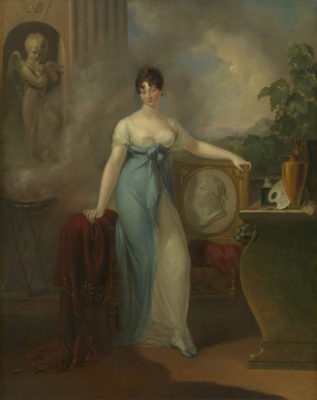New material published on Georgian Papers Online
The latest tranche of Georgian Papers has been published by the Royal Archives as part of the Georgian Papers Programme to digitise, publish, interpret and foster use of this neglected collection of historic papers. The latest batch of nearly 19,000 pages includes important collections which shed light on the lives of Princess Charlotte (1796-1817) and Princess Mary (1776-1857), two key women at the heart of the royal family. There are also continuations of the long series of George III’s and George IV’s papers. This rich and diverse group of collections sheds light on many important issues such as gender, health, material culture, and politics.
Princess Charlotte of Wales

Princess Charlotte of Wales. Royal Collection Trust / © Her Majesty Queen Elizabeth II 2020
The papers of Princess Charlotte of Wales, the daughter of George IV, comprise letters to, from and concerning the Princess, totalling over 3000 pages of which three-quarters have never been published before. She was the young and glamorous princess of early nineteenth-century Britain, the only legitimate child of the Prince Regent, and so the hopes of the nation rested on her shoulders. Yet she was a queen Britain never had: she died in childbirth aged only 21, and her baby son also died. She is the subject of a new biography by Anne Stott, the first full length study in over four decades. The publication of these papers allow access to sources which illuminate this tantalising and tragic story.
These documents reveal Princess Charlotte to have been a very passionate woman both in her romances and her intense friendships (her letters to Lady Burghursh are very gushing). She was also feisty and strong willed, shown by her letters regarding her courtship with the Prince of Orange and those when she wished to be free of her father’s restraints. They also show she was very caring and was concerned for others’ wellbeing, as there are some letters to George Sanders, a miniature painter, that are mainly asking after his health. She was also conflicted as to her loyalties between her mother and father whose separation was one of the scandals of the day.
A key topic in this collection was Charlotte’s education, which was a matter of considerable importance for the heir presumptive. It was matched only by the challenge of finding a suitable husband for a future queen of the United Kingdom. This collection also features two account books detailing Princess Charlotte’s establishment expenses between the years 1800-1805 and her poetry and prayerbooks. More details can be found in this overview or from the catalogue itself.
There are also extracts of relevant correspondence from Princess Charlotte’s aunt, Queen Charlotte of Württemberg, while some of Princess Charlotte’s household accounts lie with her father’s financial records.
Charlotte’s story is further illuminated by a blog post by her biographer Anne Stott, reflecting on the process of writing her new book about the princess. She explains her use of the Georgian Papers and material at other archives to tackle the puzzles of Charlotte’s truncated life – not least the tangled web of courtships as she and her father searched for a good husband.
A different angle on Princess Charlotte’s life is provided in a blog post by Jonathan Taylor, this year’s GPP fellow supported by the British Society for Eighteenth Century Studies. His article looks at Charlotte’s friendship with Lord Erskine – the leading Whig and former Lord Chancellor – through the medium of his poetry which she collected. This also touches on the relationship between life and art, and the restrictions upon the agency of a royal princess.
Princess Mary

Princess Mary, 1807 Royal Collection Trust / © Her Majesty Queen Elizabeth II 2020
Princess Mary, the fourth daughter of George III, went on to marry her first cousin William Frederick, Duke of Gloucester and Edinburgh, and lived well into the mid nineteenth century. Her papers, now published in their entirety for the first time, comprise some 800 letters from throughout her life, which illuminate her role as a keen observer and communicator of family, social and political developments. Just over half the letters are correspondence with her father George III and her brother George IV. A second sub-series is letters collected by Mrs Anna Maria Adams, neé Dacres, who was Mary’s wet-nurse and may have been her lady in waiting in later life. This series also includes letters from Princess Elizabeth to Adams, though the correspondence from Mary is far more extensive. More details can be found in this overview and the catalogue.
A separate series of over 1,000 almost daily reports by Princess Mary to her brother the Prince Regent about the health of their father from 1812 to at least 1814 is also published. These complement the physicians’ reports which are also in the Georgian Papers and will be a valuable resource for some of the research within the Programme to reassess the story of the king’s mental health. The catalogue and overview give more information.
Papers of George III and George IV
This tranche also includes continuations of the long series of the official papers of George III and George IV and some of their correspondence with foreign royal families.
The publication of the official papers of George III now reaches 1780, the height of the War of American Independence. This covers a period of considerable political instability, including tension in Ireland, the Gordon Riots at home and the troubled course of the American War. Here are links to a descriptive overview and the catalogue.
George IV’s official papers for 1811-1813 are now added. These cover the dramatic events of the assassination of the Prime Minister Spencer Perceval, the appointment of his successor, Lord Liverpool, and the management of the long war against Napoleonic France. Find out more from the collection overview and the catalogue.
There are also two further sets of bills documenting George IV’s Privy Purse expenditure. One covers carriages, harnesses, parks, farms, gardens, the menagerie at Sandpit Gate, bell-ringing and gun-firing, horses and racing. The other records relate to household bills and expenses for himself, Caroline, Princess of Wales, and Princess Charlotte of Wales.
